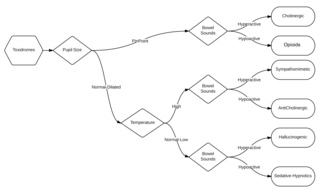Related Research Articles

Toxicology is a scientific discipline, overlapping with biology, chemistry, pharmacology, and medicine, that involves the study of the adverse effects of chemical substances on living organisms and the practice of diagnosing and treating exposures to toxins and toxicants. The relationship between dose and its effects on the exposed organism is of high significance in toxicology. Factors that influence chemical toxicity include the dosage, duration of exposure, route of exposure, species, age, sex, and environment. Toxicologists are experts on poisons and poisoning. There is a movement for evidence-based toxicology as part of the larger movement towards evidence-based practices. Toxicology is currently contributing to the field of cancer research, since some toxins can be used as drugs for killing tumor cells. One prime example of this is ribosome-inactivating proteins, tested in the treatment of leukemia.

A poison is any chemical substance that is harmful or lethal to living organisms. The term is used in a wide range of scientific fields and industries, where it is often specifically defined. It may also be applied colloquially or figuratively, with a broad sense.

A drug overdose is the ingestion or application of a drug or other substance in quantities much greater than are recommended. Typically it is used for cases when a risk to health will potentially result. An overdose may result in a toxic state or death.

A pesticide poisoning occurs when pesticides, chemicals intended to control a pest, affect non-target organisms such as humans, wildlife, plants, or bees. There are three types of pesticide poisoning. The first of the three is a single and short-term very high level of exposure which can be experienced by individuals who commit suicide, as well as pesticide formulators. The second type of poisoning is long-term high-level exposure, which can occur in pesticide formulators and manufacturers. The third type of poisoning is a long-term low-level exposure, which individuals are exposed to from sources such as pesticide residues in food as well as contact with pesticide residues in the air, water, soil, sediment, food materials, plants and animals.

Carbon monoxide poisoning typically occurs from breathing in carbon monoxide (CO) at excessive levels. Symptoms are often described as "flu-like" and commonly include headache, dizziness, weakness, vomiting, chest pain, and confusion. Large exposures can result in loss of consciousness, arrhythmias, seizures, or death. The classically described "cherry red skin" rarely occurs. Long-term complications may include chronic fatigue, trouble with memory, and movement problems.

Flumazenil is a selective GABAA receptor antagonist administered via injection, otic insertion, or intranasally. Therapeutically, it acts as both an antagonist and antidote to benzodiazepines, through competitive inhibition.

A toxidrome is a syndrome caused by a dangerous level of toxins in the body. It is often the consequence of a drug overdose. Common symptoms include dizziness, disorientation, nausea, vomiting and oscillopsia. It may indicate a medical emergency requiring treatment at a poison control center. Aside from poisoning, a systemic infection may also lead to one. Classic toxidromes are presented below, which are variable or obscured by co-ingestion of multiple drugs.
A poison control center is a medical service that is able to provide immediate, free, and expert treatment advice and assistance over the telephone in case of exposure to poisonous or hazardous substances. Poison control centers answer questions about potential poisons in addition to providing treatment management advice about household products, medicines, pesticides, plants, bites and stings, food poisoning, and fumes. In the US, more than 72% of poison exposure cases are managed by phone, greatly reducing the need for costly emergency department and doctor visits.
Toxic encephalopathy is a neurologic disorder caused by exposure to neurotoxic organic solvents such as toluene, following exposure to heavy metals such as manganese, as a side effect of melarsoprol treatment for African trypanosomiasis, adverse effects to prescription drugs, or exposure to extreme concentrations of any natural toxin such as cyanotoxins found in shellfish or freshwater cyanobacteria crusts. Toxic encephalopathy can occur following acute or chronic exposure to neurotoxicants, which includes all natural toxins. Exposure to toxic substances can lead to a variety of symptoms, characterized by an altered mental status, memory loss, and visual problems. Toxic encephalopathy can be caused by various chemicals, some of which are commonly used in everyday life, or cyanotoxins which are bio-accumulated from harmful algal blooms (HABs) which have settled on the benthic layer of a waterbody. Toxic encephalopathy can permanently damage the brain and currently treatment is mainly just for the symptoms.

The Massachusetts Department of Public Health is a governmental agency of the Commonwealth of Massachusetts with various responsibilities related to public health within that state. It is headquartered in Boston and headed by Commissioner Monica Bharel.
Ethylene glycol poisoning is poisoning caused by drinking ethylene glycol. Early symptoms include intoxication, vomiting and abdominal pain. Later symptoms may include a decreased level of consciousness, headache, and seizures. Long term outcomes may include kidney failure and brain damage. Toxicity and death may occur after drinking even in a small amount as ethylene glycol is more toxic than other diols.

Paracetamol poisoning, also known as acetaminophen poisoning, is caused by excessive use of the medication paracetamol (acetaminophen). Most people have few or non-specific symptoms in the first 24 hours following overdose. These symptoms include feeling tired, abdominal pain, or nausea. This is typically followed by absence of symptoms for a couple of days, after which yellowish skin, blood clotting problems, and confusion occurs as a result of liver failure. Additional complications may include kidney failure, pancreatitis, low blood sugar, and lactic acidosis. If death does not occur, people tend to recover fully over a couple of weeks. Without treatment, death from toxicity occurs 4 to 18 days later.

Benzodiazepine overdose describes the ingestion of one of the drugs in the benzodiazepine class in quantities greater than are recommended or generally practiced. The most common symptoms of overdose include central nervous system (CNS) depression, impaired balance, ataxia, and slurred speech. Severe symptoms include coma and respiratory depression. Supportive care is the mainstay of treatment of benzodiazepine overdose. There is an antidote, flumazenil, but its use is controversial.
Neal Flomenbaum is an emergency physician, author, editor, and an expert in emergency medicine and clinical toxicology. He is emergency physician-in-chief at NewYork-Presbyterian Hospital/Weill Cornell Medical Center; medical director of the NewYork-Presbyterian Emergency Medical Service; and professor of clinical medicine at Weill Cornell Medical College of Cornell University.
Ravindra Fernando is a Sri Lankan forensic pathologist, toxicologist, physician, author and academic. He is the current chairman of the National Dangerous Drugs Control Board of Sri Lanka.

The University of Florida's (UF) online clinical toxicology distance education programs cater to working professionals, including physicians, nurses, physician assistants, first responders, and poison control center professionals. The programs focus on toxicants, drugs of abuse, drug analysis, and biotransformation, as well as the treatment of poisoned or overdosed patients. Classes are taught by internationally recognized faculty with expertise in clinical toxicology, medicine, pharmacy, and pharmacology.
Occupational toxicology is the application of toxicology to chemical hazards in the workplace. It focuses on substances and conditions that occur in workplaces, where inhalation exposure and dermal exposure are most important, there is often exposure to mixtures of chemicals whose interactions are complex, health effects are influenced or confounded by other environmental and individual factors, and there is a focus on identifying early adverse affects that are more subtle than those presented in clinical medicine.

Poisoning is the harmful effect that occurs when too much of a poison, or substance that is harmful to the body, has been taken. Poisons can be swallowed, inhaled, injected or absorbed through the skin. Poisoning is not to be confused with envenomation.
Frank LoVecchio is an American emergency medicine physician, medical toxicologist, academic and researcher. He is the medical director of Clinical Research at College of Health Solutions, the Director of Good Samaritan Regional Poison Center, the Research Director of Maricopa Medical Center Emergency Medicine Program, and clinical professor at Arizona College of Osteopathic Medicine. He also serves as an attending physician at Valleywise Health, Phoenix Children's Hospital, and in the Department of Medical Toxicology at Banner University Medical Center.
The American Board of Applied Toxicology (ABAT) was established in 1985 as a standing committee by the American Academy of Clinical Toxicology. The board functions to recognize and credential clinical toxicologists who have demonstrated competence in the management of toxicity related to poisoning, overdose, chemical exposure, envenomation, or environmental exposures. Candidates for board certification are health professionals with minimum perquisite experience in poisoning and overdose management as well as satisfactory experience in other core areas such as toxicology research, public health, and outreach. The ABAT establishes minimum competency for clinical toxicologists via administering examinations and maintaining certification renewal of diplomates. Successfully passing the ABAT board certification exam provides the taker a designation of Diplomate of the American Board of Applied Toxicology (DABAT). A DABAT designation privileges the clinical toxicologist to provide medical back up and consultation on poisoning, drug overdoses, or toxicity, often via poison centers. The DABAT designation also has legal implication in allowing credentialed toxicologists to manage a poison center in the United States. Credentialed DABAT members must recertify every 5 years via an application demonstrating continued competence and activity in clinical toxicology.